Top 13 Lovely Birds That Can’t Fly and Full List of The Flightless Birds
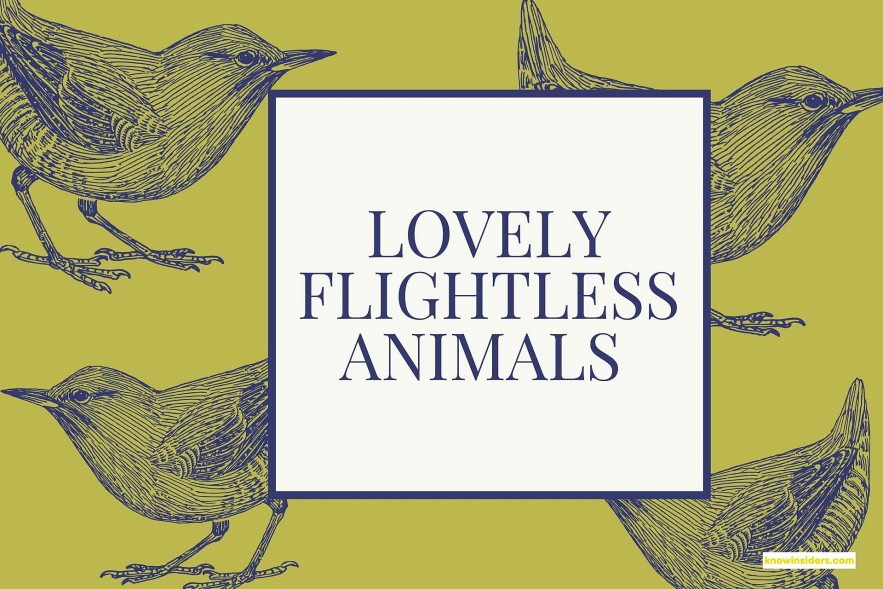 |
| Top 10 Lovely Flightless Birds . Photo KnowInsiders |
| Contents |
When talking about birds, we often think that they are all capable of flying in the sky. However, some birds possess wings but have lost the flying ability. However, in spite of being unable to fly, they still look lovely.
Ostriches, penguins, grebes, rails, and steamer ducks are just few of the numerous species of birds that are unable to fly. Over the course of ages, they underwent a process of evolution that rendered them incapable of flight, and as a result, they are now able to live without being able to fly.
In comparison to birds that are capable of flight, flightless fowl do not travel great distances and tend to be bigger overall.
Why can't some birds fly?
♦ Top 10 Wingless Animals That Can Fly Like Birds
1.Penguins
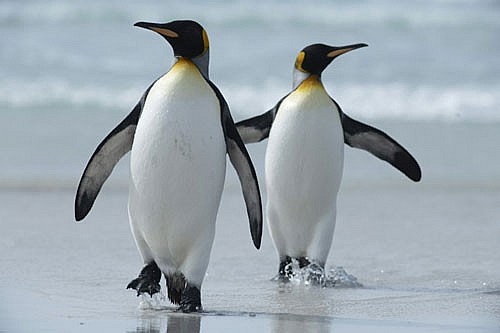 |
When it comes to birds that can't fly, penguins have to be the most well-known. None of the 17 recognized penguin species can take to the air. In contrast to the delicate and delicate feathers of avian wings, penguin wings are sturdy and compact. Penguins can't fly, but they can swim by flapping their little wings.
In the Southern Hemisphere, you will only find penguins. Eight different species of penguins may be found in Antarctica. The emperor penguin is the biggest species of penguin. They may grow to be about 1 m tall and weigh up to 35 kg. The Antarctic is completely devoid of any penguin species other than the emperor penguin.
Their heads and backs are completely covered in dark feathers, while their bellies are white and the feathers around their necks are yellow. They have the ability to hold their breath for up to 20 minutes, allowing them to dive to depths of up to 1,755 feet. They forage for food when they are submerged, looking for things like crustaceans, krill, fish, and squid.
Why do penguins have wings but can't fly?The fact that penguins can't fly has been a mystery to scientists for decades. However, a new study of uria - a species very similar to penguins in the ability to swim and dive, but can still fly - has helped provide the final answer. Scientists from the University of Aberdeen (UK) discovered that there are no birds that are good at both flying and swimming / diving. Although I don't know by, penguins are excellent swimmers. They can dive up to 564 meters deep to catch fish, squid and small crustaceans to eat. The team found that uria birds essentially use less energy than most other birds when they dive. However, the energy they need in the air is the highest of all recorded levels for a bird in flight, and 31 times more when they are at rest. When applying the new hypothesis to the case of penguins, we can see that their inability to fly may be due to the sacrifice of the function of their wings in the air in exchange for maximizing their ability to function. wings under water. |
2.Ostrich
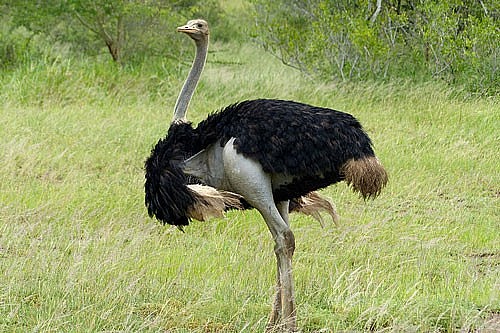 |
Ostriches are flightless and designed for running. The ostrich can sprint up to 43 mph (70 kph) and sustain 31 mph (50 kph).
Because of their weight, ostriches cannot fly. The great extinction of dinosaurs also makes the ostrich flightless. Dinosaurs' large bodies and rapid mating took up most of their environment. After their extinction, there was a lot of open territory.
Because of all this free ground, many flying animals—especially birds—adapted to earth living. Ostriches were one. The ostrich evolved and grew as time went on. Larger birds lost their capacity to fly. Ostriches' flightless ancestor is a widespread misperception. Due to these conditions, the ostrich's progenitor lost its ability to fly.
3.Cormorant
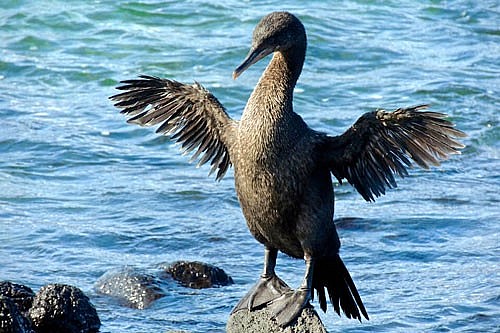 |
Flightless cormorants cannot fly. Only these cormorants can't fly, despite their ragged wings.
The bird's keel (an extension of the breastbone) is too tiny for flight, thus fewer major muscles are attached to it. The bird can flap but not fly.
Flightless cormorants hop from rock to rock using their little wings for balance.
Flightless cormorant wings lack oil, making them non-waterproof. After diving in the ocean, birds must dry their wings on rocks in the sun.
Flightless cormorants attempt to appear magnificent but fail. Their shrimpy wings sparkle in the sun, making them hilarious.
4.Takahe
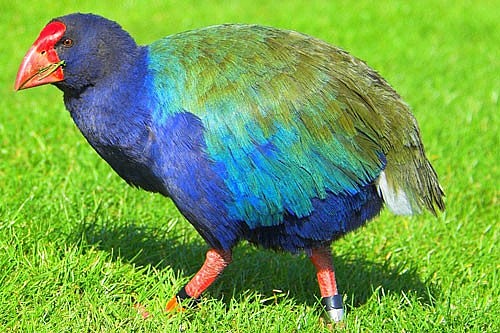 |
The takah of the South Island is an endangered remnant of New Zealand's once-extensive population of flightless vegetarian birds. Once thought to be extinct after just four specimens were captured in Fiordland between 1849 and 1898, takah were famously found in the Murchison Mountains west of Lake Te Anau in 1948. Wild takah were only found in the Murchison Mountains until the 1980s.
Because of this, many more New Zealanders may now enjoy them thanks to their relocation to seven islands and various mainland places. The Department of Conservation and other community organizations are working to save the takah and bring them back to their native habitats across their entire range. To protect the long-term survival of this precious species, DOC has partnered with Mitre 10, whose Takah Rescue program is essential to the success of the DOC's Takah Recovery Programme.
READ MORE: Top 10 Animals With Shortest Lifespan On Earth
5. Guam Rail
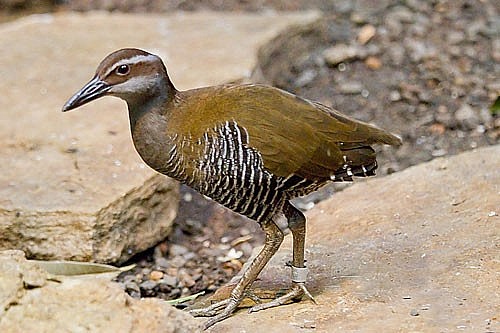 |
Guam rails are small, flightless but fast-running birds with narrow bodies. They have chocolate-brown heads and necks, and a plain gray stripe just above the eye that draws attention to their medium-length gray bills. Their lower necks and upper breasts are also gray, and they have white stripes, called bars, beneath a mantel of light brown shading to buff on the neck. The Guam rail's short wings are dark with brown spots and barred with white. Its lower breast, abdomen, under tail coverts and tail are black with white bars.
It has strong, medium-length legs and long toes that help it walk over grasses and soft marsh mud. Guam rails are small birds that grow to lengths of about 11 inches (28 centimeters) and weigh 7 to 12 ounces (200 to 350 grams). Females are slightly smaller than males, but their plumage is the same. The median life expectancy for female Guam rails is 5.7 years. For males, it is 9.5 years.
6. Tasmanian Native-Hen
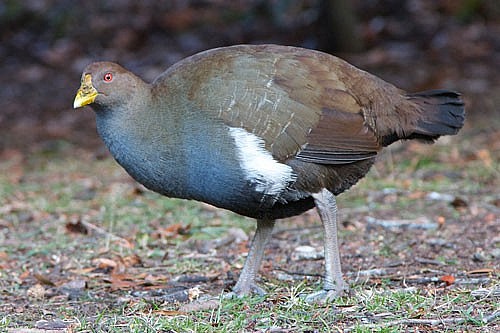 |
A Tasmania-only flightless bird. It resembles the Black-tailed Native-hen Tribonyx ventralia but is bigger. The Tasmanian Native-hen has a broad yellow beak, red eye, brown head, back, wings, and slate grey underparts. The bird's long, slender black tail is flattened midway. Powerful grey legs. Young birds are duller than adults.
The tiny Black-tailed Native-hen has red legs and a yellow eye-ring. Vagrants of the Black-tailed Native-hen have been found in Tasmania.
Seeds, leaves, and insects. Tasmanian Native-Hens forage on the ground during the day.
Two or three birds (occasionally more) create a year-round breeding group with young up to a year old in a fixed territory. Monogamous or polygamous Tasmanian Native-hens (usually polyandrous). All male birds breed with at least one female. Both sexes build, incubate, and raise chicks. Depending on seasonal circumstances, egg nests lay eggs between August and November. Grass, reeds, or herbage are used to build the egg nest on land or water.
Nighttime brooding takes place in one of many nursery nests. Egg nests are smaller and neater than nursery nests. 3–9 (typically 5–8) eggs are deposited. Incubation lasts 22 days. Parents feed chicks less till 8 weeks.
READ MORE: Top 10 Animals With the Longest Lifespan on Earth
7.Cassowary
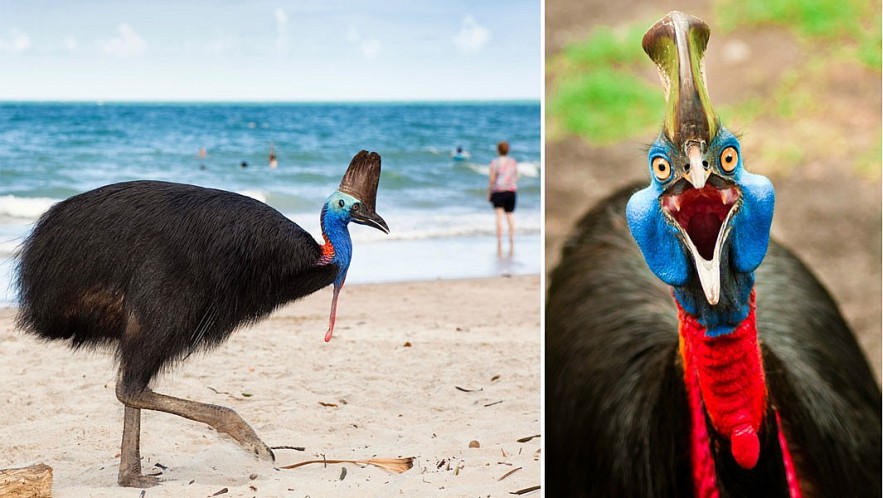 |
| Photo Guiness |
Cassowary is a large flightless bird that native to wet tropical rainforests of Papua Guinea and Northeastern Australia. It is the second largest living bird in the world. They stand between 55-79 inches in height and weigh up to 58 kg. Cassowaries are famous for their strike blue plumage and red neck. They also have a beautiful horn like the crest on their head.
This flightless, large bird has long enormously powerful legs with sharp claws. So they can defend any predator with a single kick. With the powerful legs, Cassowaries can also run up to a speed of 31 miles per hour.
8. Kakapo
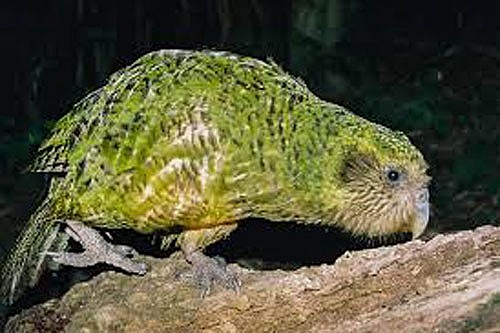 |
Adorable is the single word to describe your average kākāpo. They certainly have an individual character.
The kakapo is a species of parrot unique to New Zealand and the biggest parrot in the world. Males typically weigh 2 kg.
They can't fly thus they spend most of their time on the ground.
They may live up to 95 years, making them one of the longest-living parrot species.
Despite having flourished in New Zealand before human settlement, stoats came dangerously close to extinction due to the introduction of rodents and, subsequently, cats. It looked like that was the case for a long, but then a few specimens turned up in Fiordland. When moved for their safety, all but one of the males rapidly perished in captivity.
Stewart Island/last Rakiura's 100-200 kkpo were found in 1977 in an isolated 8,000 hectare region. They were nearly wiped off by feral cats, and just 62 kakapo, 38 males and 24 females, were rescued over the course of many years. It's fortuitous that Rakiura was never colonized by mustelids (i.e., stoats or weasels).
At its lowest point in 1995, the population consisted of just 51 birds, with just 21 of them being females.
As 2018 came to a close, there were 142 breeding adults. There were 76 chicks born in 2019, making this the highest breeding season ever recorded. Due to a productive mating season, the population has risen to almost 200, even though they are only tallied after they reach 150 days old.
The kkpo has been given the highest protection status possible by the New Zealand Department of Conservation.
About 10 full-time employees are needed at a cost of $10 million each year to assure their sustainability.
Whenua Hou/Codfish Island is 14 km2 off the west coast of Rakiura; Pukenui/Anchor Island is 11 km2 in Dusky Sound; and Little Barrier Island/Hauturu is 28 km2 near Auckland; these are the three main islands where kkpo survive in the wild today because they are devoid of predators. Predators are being eradicated from Secretary Island/Rangitoa, an area of 81.4 km2 at present.
9. Kiwi
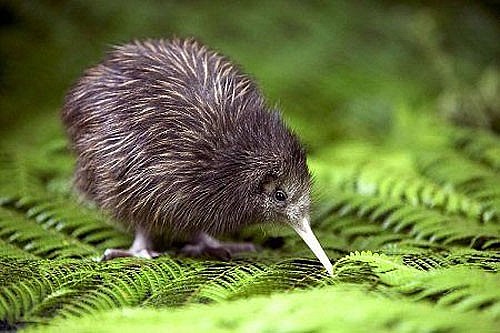 |
Kiwi is a small flightless bird that native to New Zealand. It is the smallest bird of all living ratites (family of non-flying birds) in the world. Kiwis only measure 20 inches in height and up to 2 pounds in weight. Kiwi is the national symbol of New Zealand.
There are five species of Kiwis in New Zealand – Brown Kiwi, Little spotted Kiwi, Great spotted Kiwi, Rowi and Tokoeka. Sadly, all five species of Kiwis are endangered. The first species of Kiwis evolved over 8 million years ago. This Kiwi is one of the oldest birds in the world. It is still unclear that how the flightless Kiwis appeared on Island country New Zealand.
Kiwis spend the most of their lives in forests, but they have also adapted to living in grasslands, scrublands, and hilly locations. They consume a wide variety of foods, including worms, insects, fruits, and seeds in addition to tiny invertebrates and amphibians. Their eggs may weigh up to a pound, making them one of the birds with the biggest eggs in relation to their body size.
| Kiwis are so unique among the world of birds. Because they feature a number of mammal-like characteristics. They have excellent sense of smell and hearing, hair-like plumage and dig burrows. Kiwis also have mammal-like body temperature, between 36 and 39 degree Celsius, which is lower than other birds. |
10. Inaccessible Island Rail
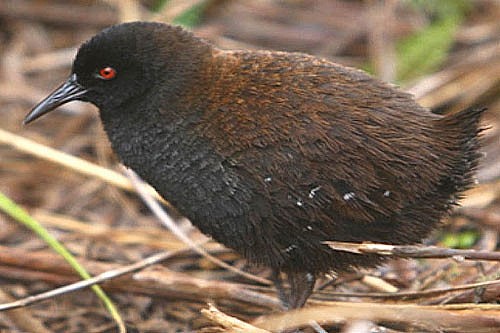 |
The island rail, found only on the remote island of New Zealand, is the world's smallest known bird that can't fly. Tristan is the world's most distant inhabited archipelago, and its inaccessible volcanic island is the only place you'll find it. They prefer to set a home on sloping grasslands. Indeed, practically everywhere on the Island has impassable rails.
Since the island where the Inaccessible Island Rails dwell is so far apart from the rest of the world, it has never had any imported predators. Due to their inability to fly, these birds have free reign over the whole Island.
The maximum length of this inaccessible rail is about 17 centimeters. Their distinctive reddish brown feathers have made them well-known. They prefer to eat in small groups and subsist mostly on fruits, nuts, and insects.
11.Emu
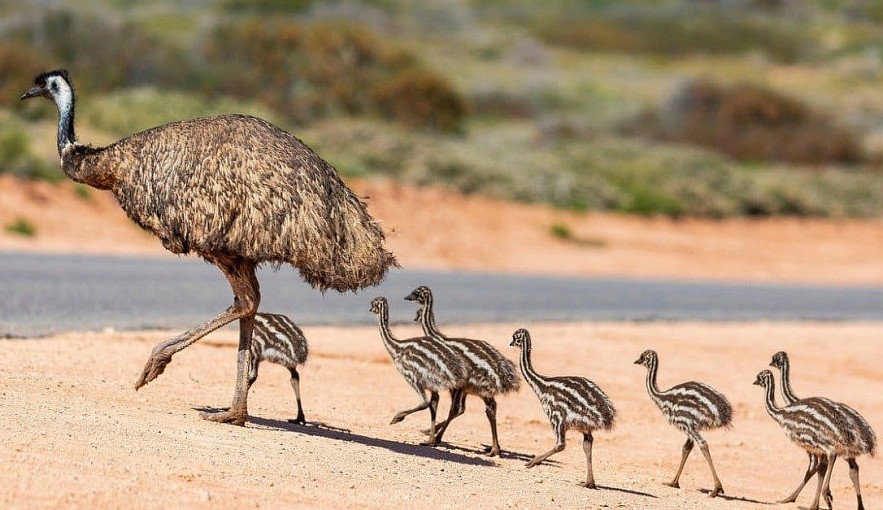 |
| The flightless emu is the second-largest bird in the world. ©iStock.com/JensenChua |
The emu is the world's second-biggest living bird species and the largest of the ratites. They may range in height from 59 to 75 inches and in weight from 40 to 132 pounds. They are native to Australia and may be found throughout the country's woodlands and savannahs but avoid the drier areas.
They can reach speeds of up to 30 miles per hour thanks to their long, muscular legs. Their feathers can range from a tan to a rusty red, depending on where they live. The seeds, grasses, fruits, and insects that make up the majority of an emu's food are found during the daytime hours while the animal is out foraging.
Males of this species of bird are the only ones that build the nest and take care of the young while they are in it. Additionally, female emus are more likely to act aggressively than males and may even engage in violent conflict for mating rights. Even though they are classified as a species of "Least Concern," they are still in danger from things like habitat loss, vehicle crashes, and alien predators.
12.Weka
The Weka is another member of the rail family that is native to New Zealand and is unable to fly.
There are four possible subspecies of the woodhen, sometimes known as the Mori hen, however this is a matter of some disagreement. They evolved powerful legs to compensate for their weak wings.
Their feathers seem like a mix of brown, black, and gray. They may range in length from 20 to 24 inches and weight from 1.1 to 3.5 pounds. Like other types of rails, a weka's tail is short and constantly wagging.
They may be found in a variety of New Zealand habitats, including forests, sand dunes, rocky coastlines, and grasslands. Grass, leaves, seeds, and berries make up the bulk of their food. Both the male and female weka contribute to the incubation of the eggs in the nest.
For reasons including invasive predators and habitat degradation, the IUCN now classifies them as Vulnerable.
13.Steamer Duck
 |
| Steamer Duck |
The flapping of wings and feet of steamer ducks gives the animal its common name. For the untrained eye, this activity might make them resemble a paddle steamer. But despite their flapping, they are classified as non-flying birds.
South America's southernmost countries, Chile and Argentina, are home to all four of the world's steamer duck species. The only one of these three species that can actually fly is the flying steamer duck.
Steamer ducks may grow to be over 15 pounds in weight and 33 inches in length. They like areas with rocks, and they feed on things like crustaceans, seeds, insects, and tiny fish. In their aggressive forms, steamer ducks are prone to fight to the death with one another. And they'll defend other species from predators like eagles and other huge waterfowl.
More Birds That Can Not Fly
As a matter of fact, over ten thousand birds don't have access to a bird's eye perspective.
So, although their avian relatives dominate the skies, flightless birds do, well, govern their territories. Loss of one sense might make one's other senses more acute, and so it is with these birds.
Moorhen
Tristan da Cunha is the birthplace of the moorhen species as we know it today. In the nineteenth century, however, their numbers plummeted, and a new species, originally from Gough Island, began to appear.
These moorhens may not be able to fly from island to island, but they are experts at swimming.
Teal from Campbell Island
Living on islands prevented the Campbell island teal from developing wings. Unfortunately, this unique species of birds is practically endangered, but nature preservers are striving to increase their number in the wild.
This Brown Mesite
Brown mesites are heavy-bodied birds that prefer humid woodland environments. Their dark feathers help them blend into the background.
It's possible that some birds can't fly because they prefer to remain concealed. But of course, the general morphology of the brown mesites renders them flightless.
A Grebe from Titicaca Lake
If you’re seeking for additional information about what birds can’t fly, then you should know about the titicaca grebe. This species has small wings and a black belly.
Even though they can't fly, titicaca grebes are nonetheless remarkable since they can dive at a speed of 2 knots.
To the Right Honourable Lord Howe Woodhens
The Lord Howe Woodhens are a member of the rail family. They are a critically endangered species that persistently strives to maintain a viable population. The woodhens have only one partner for their whole existence, and they’re highly territorial in character.
Junin Grebe
Junin grebes are unique residents of Lake Junin, and they’re distinctive owing to their crimson eyes. Although their numbers are small, they are steadily increasing via reproduction. Junin grebes are flightless fish eaters.
White Turkey with a Big Breast
The broad-breasted white turkey has the longest name of any of these non-avian species. The incapability of this fowl to fly is induced by a selective breeding method.
They are made to have greater weights and often suffer from health concerns as a result.
Coot of Prodigious Size
The enormous coots' inability to fly is mostly because to their excessive weight. Originally from South America, this species is known to reuse the water from its eggs.
What makes big coots so unique is that, while they can fly while they are young, they lose this capacity when they reach adulthood owing to their heavy build.
The Common Chicken
Domestic hens are considered flightless birds since they can only glide for short distances.
This process of fattening the birds results in a greater yield of meat. For this reason, they are unable to fly with their regular weight.
Teal Islands of Auckland
Auckland island teals are landlocked ducks that have no natural predators on their islands.
These birds are mostly brown with a little of green on their napes and a white ring around their eye. And their wingspan is little as well.
Scytalopus
The hilly regions are perfect for the scytalopus birds, who may not be able to fly but can certainly run swiftly. Stout in build, with short tails and grey to black feathering.
Due to their tiny size and rapid movement, these birds are difficult to identify in overgrown areas. And because of this ability, they have less of a chance of going extinct altogether.
Crake of Henderson Island
Long orange legs and black plumage characterize the Henderson island crakes. These birds can't fly, but they do inhabit an island where garbage is frequently collected. They have to make do with garbage for shelter because they can't fly.
Rhea, the Bigger
The bigger rheas is an intriguing choice if you need to name a flightless bird. Contrary to human nature, they engage in polygamy, with males taking on the role of egg incubator for their female partners.
Moorhen
Tristan da Cunha is the birthplace of the moorhen species as we know it today. In the nineteenth century, however, their numbers plummeted, and a new species, originally from Gough Island, began to appear.
These moorhens may not be able to fly from island to island, but they are experts at swimming.
Conclusion
The fact that certain birds are unable to fly is not an isolated occurrence. There are approximately 57 different types of birds that are unable to take flight at any point in their lives and must instead remain on the ground.
Included in this group of bird species are ratites, ducks, grebes, commorants, penguins, rails, and parrots (specifically, kakapos).
The birds that are unable to fly may never get the opportunity to experience the thrill of flight, but they do enjoy certain benefits on the ground. These birds have stronger legs and feet, and their feathers may change to suit their environment. Their anatomical make-up is optimized for their continued existence.
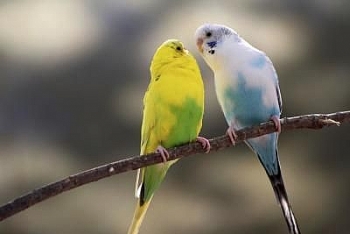 How to Take Care of Your Pet Birds How to Take Care of Your Pet Birds Birds are beautiful creatures. They are both entertaining and fun to play with - but at the same time allow you to 'get on with ... |
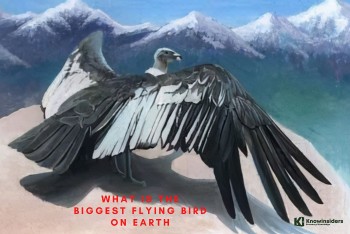 What Is The Biggest Flying Bird On Earth What Is The Biggest Flying Bird On Earth In ancient times, on earth there were many large flying that they could almost rule the whole world. Even humans were not their opponents. What ... |
 What Is The US National Bird and Why is the Bald Eagle? What Is The US National Bird and Why is the Bald Eagle? Do you know what the national bird of the UA is? Read on the article to have insightful information about the US national bird. |
























